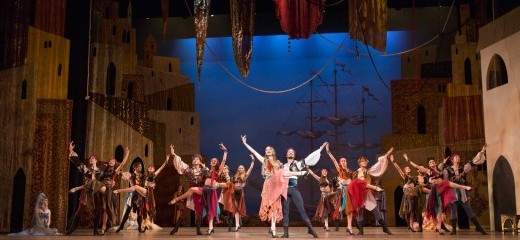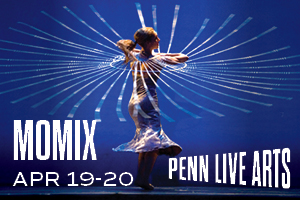
Pirates, Pashas, and Pretty Women
by Lynn Matluck Brooks
Harem girls, lovable pirates, and befuddled pashas constitute the world of Le Corsaire, a ballet dating back to 1856, loosely based on Lord Byron’s poem, The Corsair. Originally choreographed by Joseph Mazilier in Paris, it was variously restaged by Marius Petipa in the 1860s and ’80s (music by Adolphe Adam of Giselle fame, with added bits by Cesare Pugni), and has been reconceived by Angel Corella for Pennsylvania Ballet in 2017. The story is about smiling pirates stealing sensuous slave girls from paunchy pashas (what is a pasha?) and getting into and out of convoluted scrapes with one another, with slave dealers, with the pasha’s courtiers, and with the weather.
This is a work you have to take for what it is, or rather what it was—not for its odd reflection today in a world where the harem daydreams of colonial powers have become a Middle East in misery, flooding Europe not with exotic imaginaries but with exiles and immigrants. PAB’s Le Corsaire is about no world that ever existed, but rather about a lightweight excuse for the balletic fun of colorful costumes, romantic rivalries, and the triumph of some approximation of true love. It is also very much about showing off dancers’ mastery of nineteenth-century virtuosity, such as multiple fouetté turns, stage-circling split leaps, one-armed overhead lifts, aerial swivel spins that drop to dramatic floor poses, and the like. Here, I take the ballet Le Corsaire for what it is, at face value.
The opening-night cast featured the poster guys of the ballet: Arian Molina Soca as Conrad the pirate captain, Jermel Johnson as the slave dealer Lankendem, and Sterling Baca as Conrad’s “faithful servant” Ali. Also in the male mix was Etienne Diaz, as Birbanto, Conrad’s treacherous first mate, who seemed to be having altogether too much fun swashbuckling and spinning a terre and en l’air to have any ill intent toward anyone, whatever the scenario stipulated. The leading ladies were Lillian DiPiazza as harem beauty Medora, and her friend Gulnare, danced by Mayara Pineiro. The leads all danced with exuberance and finesse, despite occasional slips or shivers, managing to catch themselves skillfully on what appeared to be a somewhat slick stage surface. The lovely spins of Molina Soca, the elegant arabesques of DiPiazza, and the hyperbolic enthusiasm of Diaz were eye-catching. The real revelations, though, were in supporting roles.
Baca danced with a vivid power that gave his double split-leaps and swivel-jumps, landing on his knees, the kind of chiseled energy that drew gasps from the audience. As Ali, he seemed also to have a character with at least some depth—unlike the cardboard cut-outs that populate this ballet—in that his allegiance to his master overcomes his apparently throbbing attraction to Medora, who is Conrad’s beloved. Also a delight was Ana Calderon as one of three Odalisques entertaining the pasha; her joyful lightness sent her skimming through her solo phrases.
The costumes (I could find no credits in the program or the press release) were delicious eye candy—colorful, varied, and flowing or fluttering with the movement’s sweep. Similarly stunning were the sets by Eldar Aliev, setting the ballet in a vaguely Mediterranean town, a garlanded dreamland, and a forested, vine-laden hideaway. The work begins at sea, on the moon-lit pirate ship that sails its crew to the fateful meeting of Conrad and Medora, and after all the entanglements with slave dealers and pashas, the same ship carries the lovers off together, only to founder in a storm. Have no fear (this is a ballet)—the lovers find one another on a lonely rock as the storm subsides and give thanks for their survival. Thus has Le Corsaire survived the storms of 160 years to land, with flash and verve, on Philadelphia’s balletic shores.
Le Corsaire, Pennsylvania Ballet, The Academy of Music, March 9-19. https://paballet.org/le-corsaire
By Lynn Matluck Brooks
March 13, 2017






.png)


